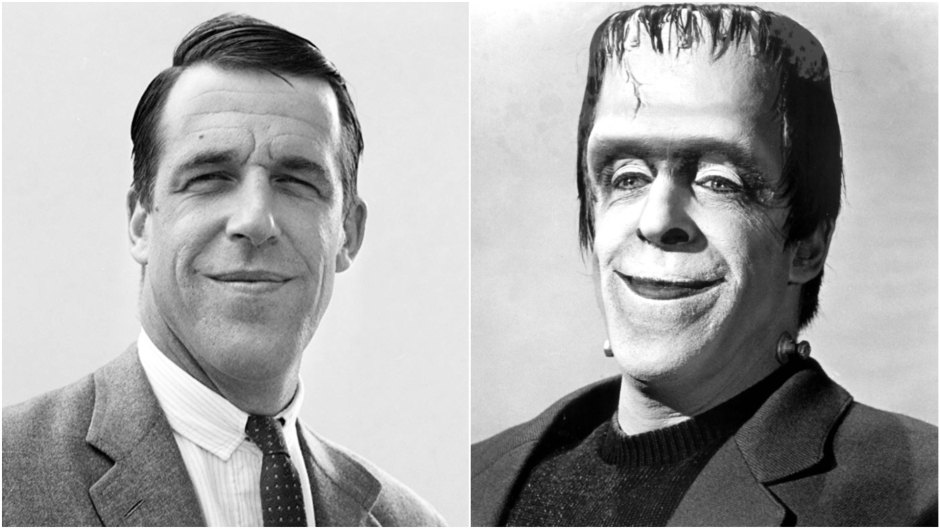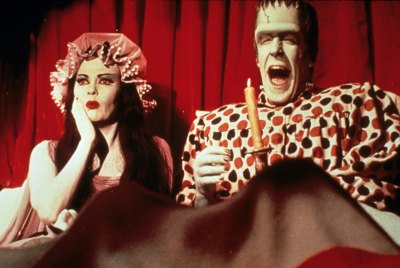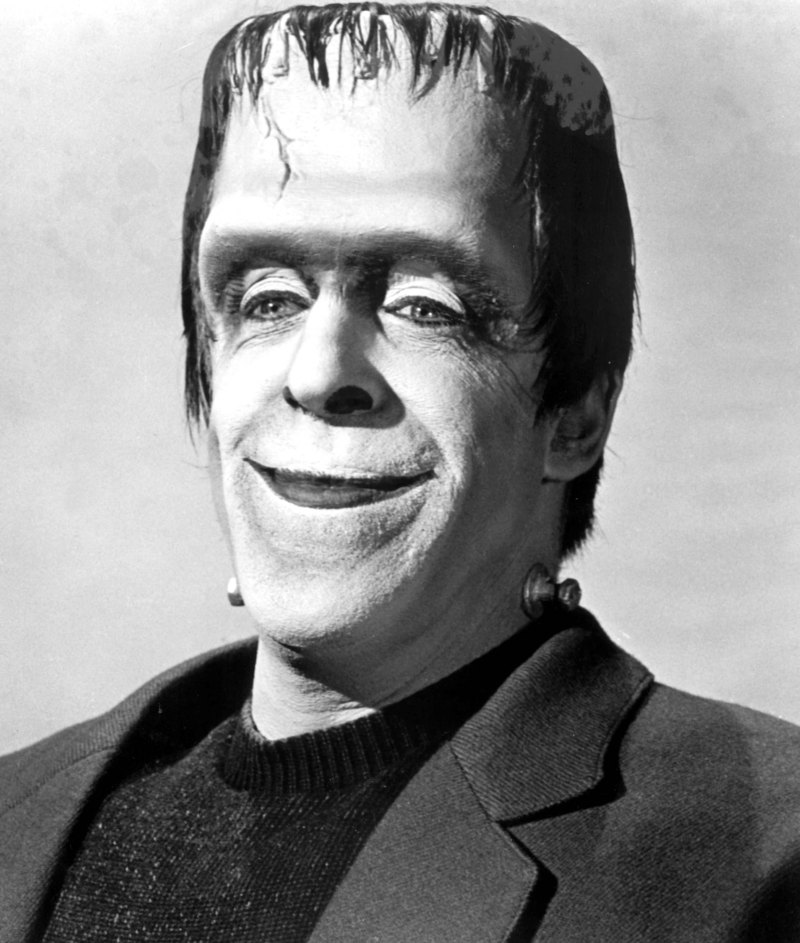
Shutterstock
Here’s What Happened to Fred Gwynne Before, During and After ‘The Munsters’: The Joys and Tragedies
Every time an actor steps on stage or in front of a camera, they’re ultimately hoping to make a connection with the audience. When they do, it can be magic — but there’s also the risk of that connection being so strong that said audience can’t see them as anyone else but that character. That’s particularly true with Classic TV, where there are so many examples ranging from George Reeves as Superman to Barbara Eden as Jeannie, Henry Winkler as Fonzie, Adam West as Batman and, of course, Fred Gwynne as Herman Munster.
Usually there are stages they go through, ranging from flattery, to shock, to frustration, anger and, ultimately, either acceptance or resignation and resentment. Fred Gwynne, unfortunately, fell into the latter category. Given the success of his 1961 to 1963 sitcom Car 54, Where Are You? — and his varied roles on stage before that — he seemed ready for a diversity in roles, but Herman did him (or least his career) in. One bright spot of The Munsters, as he related to The New York Times in 1978, is that while he didn’t get rich from the show, he did make money from it.

“I was working for Universal under what they called a minimum residual deal,” he said. “That means I got paid for the first years of reruns, but that’s all. I didn’t make money from residuals, but I invested a lot in Xerox while I was doing the show and I got out of the market at the right time, after several stock splits. So in that way The Munsters made me enough money to survive on, which made it an interesting ballgame. The money let me pursue what I wanted.”
Pursuing and achieving are two very different things as he would come to find out as it was a dilemma that he was forced to deal with through much of his career.
Please scroll down for more on Fred Gwynne.
1 of 21

Moviestore/Shutterstock
Early Life
He was born Frederick Hubbard Gwynne on July 10, 1928 in New York City to his parents Frederick, a successful stockbroker, and Dorothy, a woman with an artistic bent who created a comic strip called Sunny Jim — though, once Fred was born, he became the center of her focus. He grew up in Tuxedo Park, New York, but due to the fact that his father’s work required extensive travel, he found himself living in South Carolina, Florida and Colorado. It was a good life that came to a sudden end when his father died from what what should have been a routine sinus operation. Fred was only 8 years old. In the aftermath, he became more introspective, finding solace in the sketches he was more capable of drawing. He entered prep school at 13, and proved himself highly popular — despite a 6-foot-6 height that could have easily ostracized him. He sang in the school choir and did extremely well in his art classes, which led him to study a wide variety of artists and styles from different eras.
2 of 21

Columbia Pictures
Theater Work
After America entered World War II and Fred graduated in 1944, he enlisted in the United States Navy, where he served as a radioman on a submarine chaser. Afterwards, he used the G.I. Bill to study art and found himself enrolled at Harvard. There he was a cartoonist for The Harvard Lampoon and became its president. Additionally, he began acting in the Hasty Pudding Theatricals shows. The response he got from the audiences at school filled him with a desire to pursue acting even more. Following his 1951 graduation, he joined the Brattle Theatre Repertory Company, but ended up coming back to New York City. To earn a living, he started working as a copywriter for advertising agency J. Walter Thompson — which he resigned from a year later when he found himself cast in the the Broadway play McThing, playing a gangster opposite Helen Hayes. In 1954, he portrayed a character named Slim in On the Waterfront. Also, although he’d been on television in the early 1950s in The Repertory Theatre and two episodes of You Are There, there were much bigger things on the horizon.
3 of 21

Kobal/Shutterstock
Featured Player
Geoffrey Mark, writer and co-director of the 2002 documentary Behind the Fame: The Munsters/Addams Family, muses, “I don’t know if you’d call him a big Broadway star, but Fred was a featured player in play after play after play in the 1950s, doing a lot of comedy and singing. And this led him to doing live television and being seen by television people.”
4 of 21

CBS Television Disribution
Sitcom Star
Among them was comedian Phil Silvers, who had caught Fred’s performance in McThing and cast him in a pair of episodes of The Phil Silvers Show. Says Geoffrey, “This led to one of the most unique sitcoms that was ever done: Car 54, Where Are You?, which was created by a man named Nat Hiken, who had created The Phil Silvers Show and, like that show, was done in New York on film as opposed to being done in front of a live audience in Hollywood.”
5 of 21

Moviestore/Shutterstock
Big Success
The series saw Fred cast as Officer Francis Muldoon and costarring with Joe E. Ross as Officer Gunther Toody. They’re assigned to Patrol Car 54, and the show follows them in their misadventures as they try to keep New York safe. The series, which ran from 1961 to 1963, was nominated for four Emmy Awards, with series creator Nat Hiken taking home the gold for Outstanding Directorial Achievement in Comedy.
6 of 21

Nbc-Tv/Kobal/Shutterstock
Comedy Actor
“The hallmark of things like The Phil Silvers Show and Car 54 is that there’s almost no character in them that’s real,” Geoffrey points out. “They’re satires, almost cartoonish in the way the characters are written. And if there was a straight man on this show, Fred is the straight man, but funny as hell. And the cast is absolutely amazing. The other people in the show ended up being all over television. They all would move to the West Coast and became icons, like Charlotte Rae and Al Lewis — who had a smaller part on Car 54, but ended up being Grandpa on The Munsters.”
7 of 21

Moviestore/Shutterstock
The ’60s
“So the show ran for two years in New York and it was shot all around new York City,” he adds. “In fact, New York City became almost their playground and the show was critically acclaimed, but as sometimes used to happen back in those days, it was on the wrong network. If they’d been on CBS, it would have run for years, but NBC didn’t know what to do with sitcoms in those days. Right after that was over, they began casting for The Munsters, which fit into that period of the early 1960s, which was a very precarious time for television situation comedies.”
8 of 21

Clockwise From Top Left: Shutterstock (3), NBCUniversal, Warner Bros
‘The Munsters’
That precarious situation, he notes, came in the aftermath of the 1963 assassination of President John F. Kennedy. “Once that happened, once the Civil Rights movement had started, once we were in Vietnam, the culture of television was not to portray anything that seriously in a comedic sort of way,” Geoffrey details. “So sitcoms could not reflect on death and despair and war or anything racist. You just couldn’t do it. So there began this fad, and it lasted for several years, of these fantasy sitcoms with genies, martians, monsters and witches. They were unreal and far removed from what was actually happening in our country, and The Munsters was certainly among the better of them. It was extraordinarily well cast.”
9 of 21

NBCUniversal
Color Television
“The original pilot of The Munsters was done in color,” he elaborates. “Al Lewis was there, but the rest of the cast was different, with Joan Marshall playing Lily Munster. But they recast the show and decided to do it in black and white, because CBS was not yet regularly putting on color television shows when this debuted in 1964.”
10 of 21

Moviestore/Shutterstock
Horror Movie Hybrid
The Munsters was a hybrid of the old Universal horror movies from the 1930s and 1940s (Dracula, The Wolfman, Frankenstein, etc.) and a more modern sitcom, specifically The Donna Reed Show. The cast featured Fred as Frankenstein Monster Herman, Yvonne De Carlo as his wife, vampiress Lily; Butch Patrick as their son, Eddie “Wolfgang” Munster; Al Lewis as Grandpa (presumably Dracula) and first Beverly Owen and then Pat Priest as niece Marilyn, who was perfectly normal looking, but accepted by the family anyway.
11 of 21

Moviestore/Shutterstock
Becoming the Character
Observes Geoffrey, “The Munsters was extraordinarily hard for Fred to do. He was already 6-foot-5-and-a-half inches and they put him in these buildup shoes in which he could hardly walk. And, of course, makeup that took hours to put on every day. Al Lewis was 6-foot-2, and he’s staring up at Fred, because now he’s so much taller. On top of that, it’s not easy to do comedy without an audience. And then, anytime you play a character like Herman, there’s a boomerang effect. If the show goes well, you won’t be thought of as anything else.”
12 of 21

Moviestore/Shutterstock
Pop Culture Icon
Without even knowing it, although The Munsters only ran from 1964 to 1966, Fred had secured his place in pop culture history from that point on, creating a portrayal that would be beloved for generations to come. Also, even though the show ended its run after just two seasons, that was the same time it was starting to be shown in Europe. For the sake of spreading the word about it, a theatrical movie version was created with the cast reprising their roles. One key difference: While the show was in black and white, the movie, Munster Go Home, was in color.
13 of 21

Universal Pictures
Private Life
Beyond typecasting, there seemed to be something else that prevented Fred from really wanting to revisit those years throughout the rest of his life. In an exclusive interview with Closer Weekly, author Stephen Cox, who wrote The Munsters: A Trip Down Mockingbird Lane, suggested, “When I wrote the book The Munsters back in the 1980s, Gwynne did not wish to participate. He didn’t want to go back there. I didn’t know it when I’d reached him by phone that he and his wife had a son drown in a pool during those years, but I have a strong feeling he didn’t want to discuss that part of his life. Actually, I was unaware, so I would not have asked him about that anyway. I liked Fred Gwynne and he was kind about asking for a copy of the book, which I certainly obliged — he responded with some autographed items for me. But he just didn’t want to revisit it, sadly.”
14 of 21

Family
While Fred was building his career, he had married socialite Jean “Foxy” Reynard in 1952, and together they had five children. They were Gaynor, born 1952; Kieron, born 1954; Evan, born 1956; Madyn, born 1965; and Dylan, who was born in 1962 but drowned in the family pool a little less than a year later. On top of this, Kieron, at the age of a 1, suffered a severe brain injury that left him mentally disabled. One can only imagine the personal pain this must have caused Fred, which could have colored his personality for the rest of his life (he was often called a “curmudgeon” by the media).
15 of 21

NBCUniversal
Personal Battles
“It had such a devastating effect on him,” says Geoffrey, “but he kept that very much to himself. When he was acting, he acted, but offscreen he was a bereaved parent. Between all of that and how hard he was finding it to get work, he bought a farmhouse in Maryland and retreated into that very private life. I want to say this nicely, but people who are big fans of any person or show, when they hear that their favorite actor has suffered so much, they feel as though their suffering is more important than anybody else’s. Fred always had his feet on the ground. He never used his personal tragedies as fodder for publicity. Nor did he want to cry in public over what he was dealing with. He knew that there were tons of other people going through the same things and he dealt with it privately. He really did not care to share.”
16 of 21

NBCUniversal
Finding Roles
Although he had a hard time scoring movie and TV roles following The Munsters, Fred found solace in the theatre, starring in a number of regional state productions across the country before making his way back to Broadway in 1974 for a revival of Cat on a Hot Tin Roof, followed two years later by A Texas Trilogy. Points out Geoffrey, “It’s not that he didn’t work at all, it’s just that there wasn’t another high profile sitcom. What he became was a wonderful, well-paid character actor. He went back to Broadway and was a star there, because he could play all kinds of parts. He was Broadway-trained and could live quietly working onstage, and then slipping away back to the suburbs to get far away from all of it. That’s how he lived his life.”
17 of 21

Scholastic Books
Illustrations
He also more fully embraced his artistic bent, creating more paintings and serving as both writer and illustrator of a number of children books, among them A Chocolate Moose for Dinner, The King Who Rained, A Little Pigeon Toad and Pondlarker. “Wise people reinvent themselves,” muses Geoffrey. “Fred reinvented himself as a magnificent character actor, went back to Broadway and then became an author and an illustrator. He used his talents to fulfill himself in a way that he could no longer do as the star of a show.”
18 of 21

Paramount/Kobal/Shutterstock
Reunion
In 1981, whatever his feelings for The Munsters, Fred agreed to reprise the role of Herman in the TV reunion movie The Munsters’ Revenge — reportedly he demanded an outrageous payment for it, and everyone else agreed. Something else began to happen in the 1980s: directors began casting him in character parts in their movies, such as The Cotton Club, The Secret of My Success, Water, Ironweed, Fatal Attraction and The Boy Who Could Fly. In 1989 he made quite an impression on audiences with his portrayal of Jud Crandall in the adaptation of Stephen King’s Pet Sematary. “I see it as a frightening fable rather than a horror film, which I think makes it doubly strong,” he told the Sun-Sentinel. “I’d read the book as soon as it came out. I’m a Stephen King nut. I saw it more as a fable for our times.”
19 of 21

Snap/Shutterstock
Biggest Successs
However, his greatest success in the latter part of his career, which ironically would be his last role, was as Judge Chamberlain Haller in 1992’s My Cousin Vinny. The back and forth between he and Joe Pesci’s Vincent “Vinny” Gambini is delightful fun. “And there wasn’t a Baby Boomer who watched that film who didn’t on some level at first chuckle just seeing him there, and then got sucked into it,” laughs Geoffrey. “You just bought that character. That’s how good Fred was. There was that moment of recognition and a giggle, and then he pulled you right in, because he was such a good actor.”
20 of 21

Snap/Shutterstock
Legacy
Sadly, in the midst of what was a true career renaissance, Fred was diagnosed with pancreatic cancer. He ended up dying on July 2, 1993, only eight days before he would have turned 67. “Fred was an actor,” Geoffrey closes, “who knew how to play comedy with incredible pinpoint, sharp timing. Like Lucille Ball, he knew how to suspend disbelief so that you could completely buy what was going on. For me, The Munsters is a cartoon — only we believe it because Fred believes it. There was a warmth and a heart that came out of him that made what he did believable.”
21 of 21







































